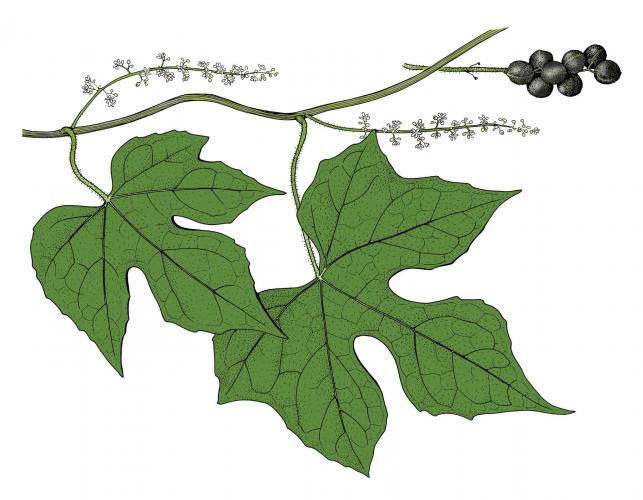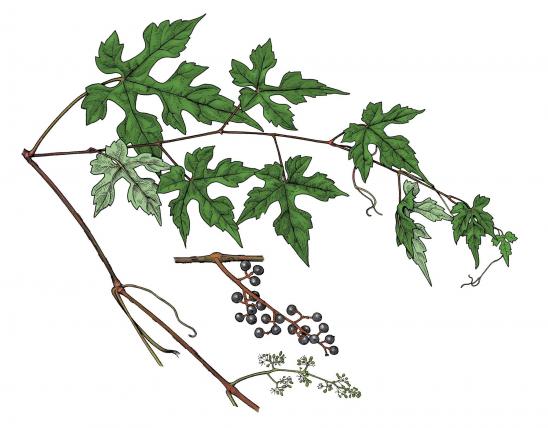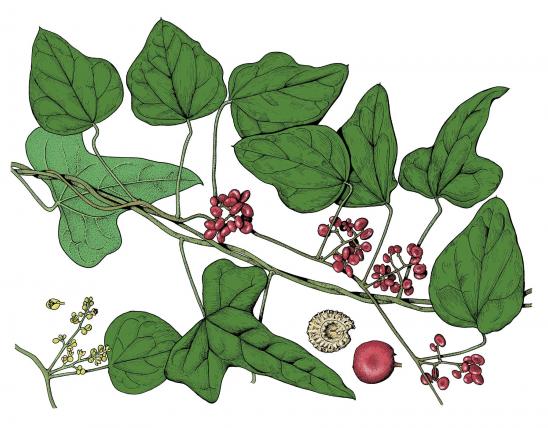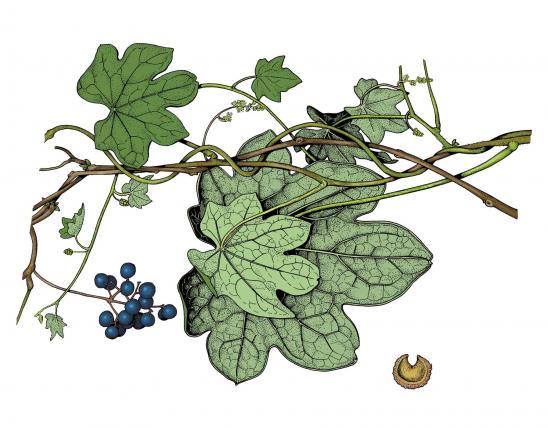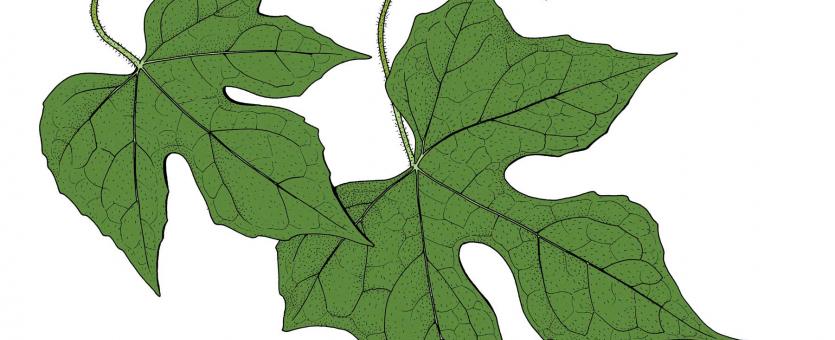
Cupseed is a relatively stout, robust twining vine to 30 feet that dies back to the ground in severe winters. It is scattered south of the Missouri River. It bears clusters of black fruits. The seeds are shaped like little cups. The large grapelike leaves and cup-shaped seeds are the most distinctive characteristics of this vine.
Leaves are alternate, simple, with 5 or 7 veins radiating out from a base; variable in size, 3–8 inches long, 3–7 inches wide, rounded to egg-shaped overall, the margin with 3 or 5 (or sometimes 7) shallow to deep lobes, the end lobe usually egg-shaped; sinuses between the lobes are rounded, the lobe tips pointed, the leaf base broadly heart-shaped; upper surface dark yellow green, smooth; lower surface slightly paler, with scattered long, straight hairs on the veins; leaf stalk 2½–6 inches long, smooth to hairy, with fine grooves and ridges. Leaf texture is thin, tender, wilting rapidly if picked.
Stems are smooth, flexible, yellowish brown, with fine grooves and ridges; dies back near the ground each winter; tendrils absent.
Bark is greenish to brown, finely ridged; wood white, soft, weak.
Flowers June–July, sometimes also in September–October, in drooping clusters at the leaf axils on new growth; male and female flowers in separate clusters; male flowers in loose, many-flowered clusters 3–6 inches long, cluster stalk finely hairy; flowers minute; calyx lobes 6, distinct, spreading, white; petals absent; stamens 6–12, not fully developed.
Fruits September–October, in crowded, grapelike clusters 1½–3½ inches long; fruit stalks finely hairy; fruit oval to globe-shaped, smooth, about ¾ inch long and wide, starting as green, drying to bluish black, becoming slightly yellowish and soft before falling; seed yellowish brown, shaped like a hollow bowl or cup, with a keel on the round side, ½–¾ inch long, about ½ inch wide, with a ¼-inch depression, shell thin, smooth, hard, the edge of the rim with small, close, sharp teeth.
Similar species: Cupseed might be confused with our several species of wild grapes, which are in a different family. In particular, red grape (Vitis palmata) has leaves very similar in shape to cupseed, and summer grape (V. aestivalis) can have leaves like it, too.
- Because they grow in similar kinds of habitats and bear fruits that superficially look rather similar, and because grapes are edible and cupseed is toxic if eaten, it is important to be able to distinguish between them. Key characters for identifying grapes are their toothed leaves, the curling tendrils by which they climb, and their seeds, which are neither bowl-shaped nor disk-shaped.
Silver maple (Acer saccharinum) and paper mulberry (Broussonetia papyrifera) are two other species that have leaves that rather resemble those of cupseed, but they are trees or shrubs, not vines, and their leaves are toothed.
Habitat and Conservation
Status
Human Connections
Cupseed is an interesting plant that is suitable for planting along borders in partial shade. Although it dies back near to the ground in hard winters, it rebounds in the spring and summer with its vigorous growth. If eaten, the fruits are toxic to people and other mammals. If you have small children or pets, this might not be a good plant to cultivate in an area where they may eat them.
The genus name, Calycocarpum, is derived from the Greek word calyx (“a cup”) and carpos (“a fruit”), referring to the cup-shaped seeds; the species name, lyonii, is named for its discoverer, John Lyon, an English botanical explorer of North America before 1818.
Ecosystem Connections
Cupseed is one of many plants characteristic of Missouri’s bottomland forest and streamside habitats. These habitats, and the plant communities that grow in them, are crucial buffers for absorbing the scouring impact of high-energy floods. They protect levees, which protect cropland and other areas of interest to people. Where bottomland forests absorb low-energy floods, rich, deep sediments accumulate, creating highly prized, fertile cropland.
Bottomland and other lowland forests, defined by the assemblage of plants in them, including cupseed, protect water quality by preventing soil from being washed into streams and by absorbing nutrients, fertilizers, and pollutants.
Bottomland forests provide important habitat for migratory birds traveling between North America and the tropics. Many of Missouri’s resident breeding birds nest in the trees and other thick vegetation along rivers. Many other animals, large and small, find shelter and plentiful food in bottomland forest habitats.
Apparently, flies and bees visit the flowers.
